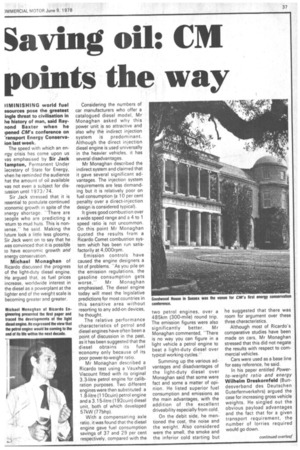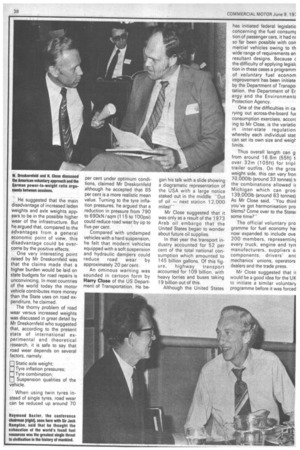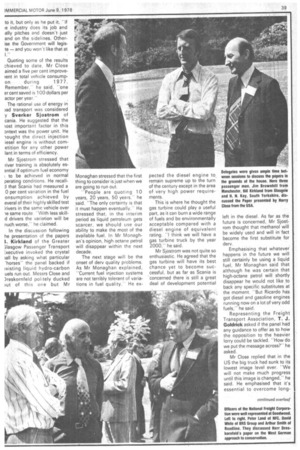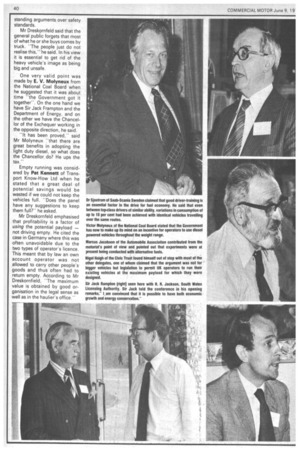saving oil: CM points the way
Page 39

Page 40

Page 41

Page 42

If you've noticed an error in this article please click here to report it so we can fix it.
IIMINISHING world fuel asources pose the greatest. ingle threat to civilisation in he history of man, said Raymond Baxter when he
• pened CM's conference on "ransport Energy Conserveion last week.
The speed with which an enTgy crisis has come upon us vas emphasised by Sir Jack lampton, Permanent Under ;ecretary of State for Energy, vhen he reminded the audience hat the amount of oil available vas not even a subject for dis:ussion until 1973/74.
Sir Jack stressed that it is :ssential to postulate continued )conomic growth in spite of the )nergy shortage. "There are People who are predicting a .eturn to mud huts. This is nonsense," he said. Making the future look a little less gloomy, Sir Jack went on to say that he as convinced that it is possible to have economic growth and energy conservation.
Michael Monaghan of Ricardo discussed the progress of the light-duty diesel engine. He argued that, as fuel prices increase, worldwide interest in the diesel as a powerplant at the lighter end of the weight scale is becoming greater and greater. Considering the numbers of car manufacturers who offer a catalogued diesel model, Mr Monaghan asked why this power unit is so attractive and also why the indirect injection system is predominant. Although the direct injection diesel engine is used universally in the heavier vehicles, it has several disadvantages.
Mr Monaghan described the indirect system and claimed that it gave several significant advantages. The injection system requirements are less demanding but it is relatively poor on fuel consumption (a 10 per cent penalty over a direct-injection design is considered typical).
It gives good combustion over a wide speed range and a 4 to 1 speed ratio is not uncommon. On this point Mr Monaghan quoted the results from a Ricardo Comet combustion system which has been run satisfactorily at 4,000rpm Emission controls have caused the engine designers a lot of problems. "As you pile on the emission regulations, the gasoline consumption gets worse," Mr Monaghan emphasised, The diesel engine today will meet the legislative predictions for most countries in this sensitive area without resorting to any add-on devices, he thought.
The relative performance characteristics of petrol and diesel engines have often been a point of discussion in the past, as it has been suggested that the diesel obtains its fuel economy only because of its poor power-to-weight ratio.
Mr Monaghan described a Ricardo test using a Vauxhall Viscount fitted with its original 3.3-litre petrol engine for calibration purposes. Two different engines were then substituted a 1.8-litre (110cuin) petrol engine and a 3.15-litre (192cuin) diesel unit, both of which developed 57kW (77bhp).
With a compensating axle ratio, it was found that the diesel engine gave fuel consumption savings of 37 and 29 per cent respectively, compared with the two petrol engines, over a 485km (300-mile) round trip. The emission figures were also significantly better. Mr Monaghan commented, "There is no way you can figure in a light vehicle a petrol engine to beat a light-duty diesel over typical working cycles."
Summing up the various advantages and disadvantages of the light-duty diesel over Monaghan said that some were fact and some a matter of opinion. He listed superior fuel consumption and emissions as the main advantages, with the addition of the excellent driveability especially from cold.
On the debit side, he mentioned the cost, the noise and the weight. Also considered were the smell, the smoke and the inferior cold starting but he suggested that there was room for argument over these three characteristics.
Although most of Ricardo's comparative studies have been made on cars, Mr Monaghan stressed that this did not negate the results with respect to commercial vehicles.
Cars were used as a base line for easy reference, he said.
In his paper entitled Powerto-weight ratio and energy Wilhelm Dreskomfeld (Bundesverband des Deutschen Guterfernverkehrs) argued the case for increasing gross vehicle weights. He singled out the obvious payload advantages and the fact that for a given transport requirement, the number of lorries required woufd go down.
He suggested that the main disadvantage of increased laden weights and axle weights appears to be in the possible higher wear of the infrastructure. But he argued that, compared to the advantages from a general economic point of view, this disadvantage could be overcome by the positive effects.
One very interesting point raised by Mr Dreskornfeld was that the claims made that a higher burden would be laid on state budgets for road repairs is unconvincing. In most countries of the world today the motor vehicle contributes more money than the State uses on road expenditure, he claimed.
The thorny problem of road wear versus increased weights was discussed in great detail by Mr Dreskornfeld who suggested that, according to the present state of international experimental and theoretical research, it is safe to say that road wear depends on several factors, namely Static axle weight; Tyre inflation pressures; Tyre combination; [1] Suspension qualities of the vehicle.
When using twin tyres instead of single tyres, road wear can be reduced up around 70 per cent under optimum conditions, claimed Mr Dreskornfeld although he accepted that 85 per cent is a more realistic mean value. Turning to the tyre inflation pressures, he argued that a reduction in pressure from 790 to 690kN /sqm (115 to 100psi) could reduce road wear by up to five per cent.
Compared with undamped vehicles with a hard suspension, he felt that modern vehicles equipped with a soft suspension and hydraulic dampers could reduce road wear by approximately 20 per cent.
An ominous warning was sounded in cartoon form by Harry Close of the US Department of Transportation. He be gan his talk with a slide showing a diagramatic representation of the USA with a large notice staked out in the middle: "Out of oil — next station 12,000 miles!"
Mr Close suggested that it was only as a result of the 1973 Arab oil embargo that the United States began to wonder about future oil supplies.
In that year the transport industry accounted for 52 per cent of the total national consumption which amounted to 145 billion gallons. Of this fig ure, highway transport accounted for 109 billion, with heavy lorries and buses taking 19 billion out of this.
Although the United States
has initiated federal legislatio concerning the fuel consumr tion of passenger cars, it had nc so far been possible with con mercial vehicles owing to th wide range of requirements an resultant designs. Because c the difficulty of applying legislE tion in these cases a programm of voluntary fuel econom improvement has been initiate by the Department of Transpo tation, the Department of Er ergy and the Environments Protection Agency.
One of the difficulties in ca rying out across-the-board fu( consumption exercises, accorc ing to Mr Close, is the variatio in inter-state regulation whereby each individual stat can set its own size and weigllimits.
Thus overall length can g from around 16.8m (55ft) t,
over 32m (105ft) for tripl trailer outfits. On the gros weight side, this can vary fron 7-3,000lb (around 33 tonnes) ti the combinations allowed it Michigan which can gros: 139,000lb (around 63 tonnes) As Mr Close said, "You thinl you've got harmonisation pro blems? Come over to the State! some time?"
The official voluntary pro gramme for fuel economy ha: now expanded to include ove 200 members, representinc every truck, engine and tyrc manufacturers, suppliers o components, drivers' anc mechanics' unions, operators dealers and the trade press.
Mr Close suggested that il would be a good idea for the UK to initiate a similar voluntary programme before it was forced
to it, but only as he put it, "if le industry does its job and ally pitches and doesn't just and on the sidelines. Otherise the Government will legiste — and you won't like that at I."
Quoting some of the results hieved to date, Mr Close aimed a five per cent improvelent in total vehicle consump
on during 1977, Remember," he said, "one er cent saved is 100 dollars per actor per year.
The rational use of energy in )ad transport was considered y Sverker Sjostrom of cania. He suggested that the lost important factor in this antext was the power unit. He nought the direct injection iesel engine is without cornetition for any other power lant in terms of efficiency.
Mr Sjostrom stressed that river training is absolutely esential if optimum fuel economy to be achieved in normal perating conditions. He recall
that Scania had measured a 0 per cent variation in the fuel onsumption achieved by everal of their highly skilled test Irivers in the same vehicle over le same route. "With less skilld drivers the variation will be nuch worse,he claimed.
In the discussion following he presentation of the papers I. Kirkland of the Greater 31asgow Passenger Transport ixecutive invoked the crystal )all by asking what particular 'horsesthe panel backed if :xisting liquid hydro-carbon uels run out. Messrs Close and )reskornfeld politely ducked )ut of this one but Mr
Monaghan stressed that the first thing to consider is just when we are going to run out.
"People are quoting 10 years, 20 years, 50 years," he said. "The only certainty is that it must happen eventually.He stressed that, in the interim period as liquid petroleum gets scarcer, we should use our ability to make the most of the available fuel. In Mr Monaghan's opinion, high octane petrol will disappear within the next decade.
The next stage will be the onset of dery quality problems. As Mr Monaghan explained, "Current fuel injection systems are not terribly tolerant of variations in fuel quality." He ex pected the diesel engine to, remain supreme up to the turn of the century except in the area of very high power requirements.
This is where he thought the gas turbine could play a useful part, as it can burn a wide range of fuels and be environmentally acceptable compared with a diesel engine of equivalent rating. "I think we will have a gas turbine truck by the year 2000," he said.
Mr Sjostrom was not quite so enthusiastic. He agreed that the gas turbine will have its best chance yet to become successful, but as far as Scania is concerned there is still a great deal of development potential left in the diesel. As far as the future is concerned, Mr Sjostrom thought that methanol will be widely used and will in fact become the first substitute for derv.
Emphasising that whatever happens in the future we will still certainly be using a liquid fuel, Mr Monaghan said that although he was certain that high-octane petrol will shortly disappear he would not like to back any specific substitutes at the moment. "But Ricardo has got diesel and gasoline engines running now on a lot of very odd fuels," he said.
Representing the Freight Transport Association, T. J. Goldrick asked if the panel had any guidance to offer as to how the opposition to the heavier lorry could be tackled. "How do we put the message across?" he asked.
Mr Close replied that in the US the big truck had sunk to its lowest image level ever. -We will not make much progress until this image is changed," he said. He emphasised that it's essential to overcome long
standing arguments over safety standards.
Mr Dreskprnfeld said that the general public forgets that most of what he or she buys comes by truck. The people just do not realise this," he said. In his view it is essential to get rid of the heavy vehicle's image as being big and unsafe.
One very valid point was made by E. V. Molyneux from the National Coal Board when he suggested that it was about time "the Government got it together". On the one hand we have Sir Jack Frampton and the Department of Energy, and on the other we have the Chancellor of the Exchequer working in the opposite direction, he said.
"It has been proved," said Mr Molyneux "that there are great benefits in adopting the light duty diesel, so what does the Chancellor do? He ups the tax."
Empty running was considered by Pat Kennett of Transport Know-How Ltd when he stated that a great deal of potential savings would be wasted if we could not keep the vehicles full. "Does the panel have any suggestions to keep them full?" he asked.
Mr Dreskornfeld emphasised that profitability is a factor of using the potential payload — not driving empty. He cited the case in Germany where this was often unavoidable due to the two types of operator's licence. This meant that by law an own account operator was not allowed to carry other people's goods and thus often had to return empty. According to Mr Dreskornfield, -The maximum value is obtained by good organisation in the legal sense as well as in the haulier's office.




















































































































































